2015 NISSAN FRONTIER warning light
[x] Cancel search: warning lightPage 10 of 466
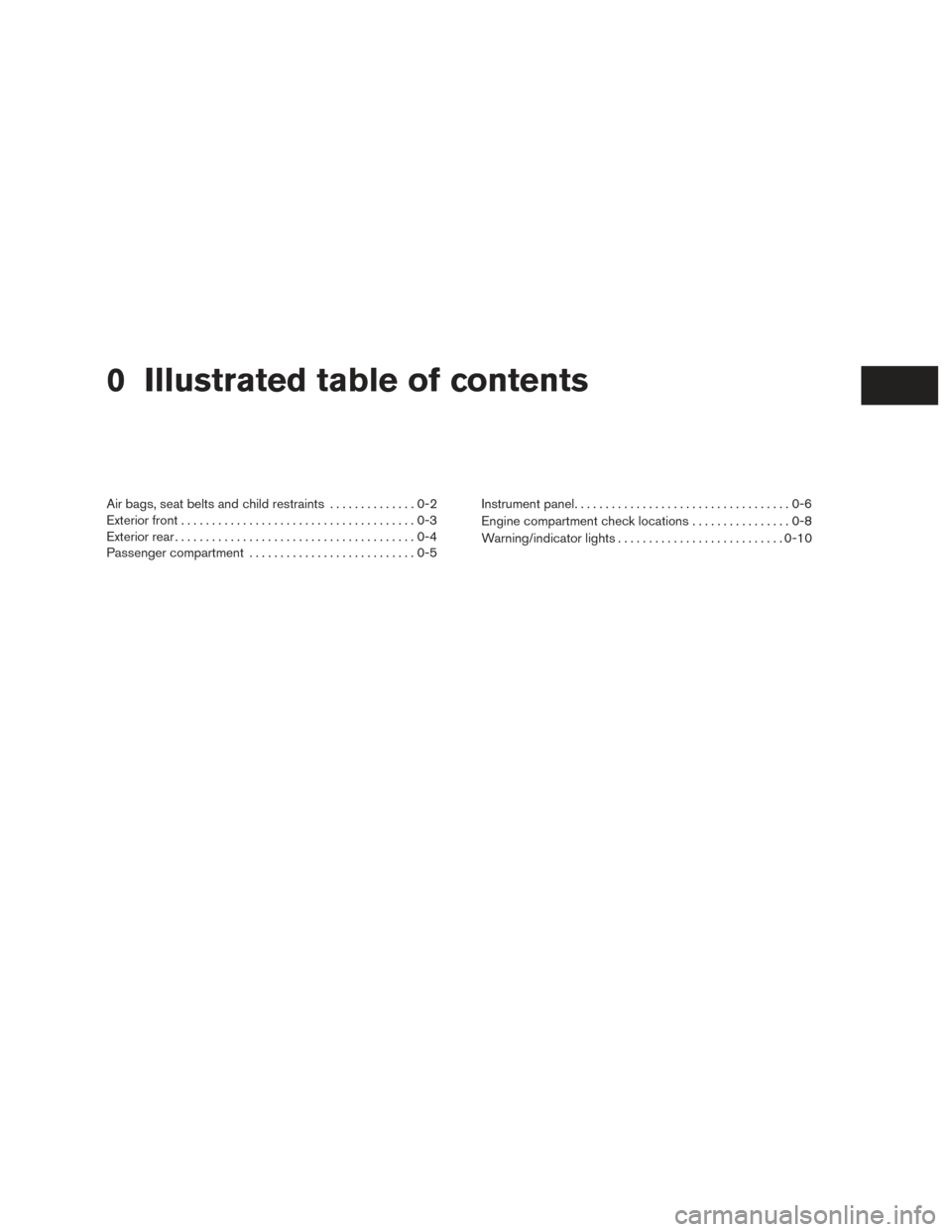
0 Illustrated table of contents
Air bags, seat belts and child restraints..............0-2
Exterior front ......................................0-3
Exterior rear .......................................0-4
Passenger compartment ...........................0-5 Instrument panel
...................................0-6
Engine compartment check locations . . ..............0-8
Warning/indicator lights ........................... 0-10
Page 15 of 466
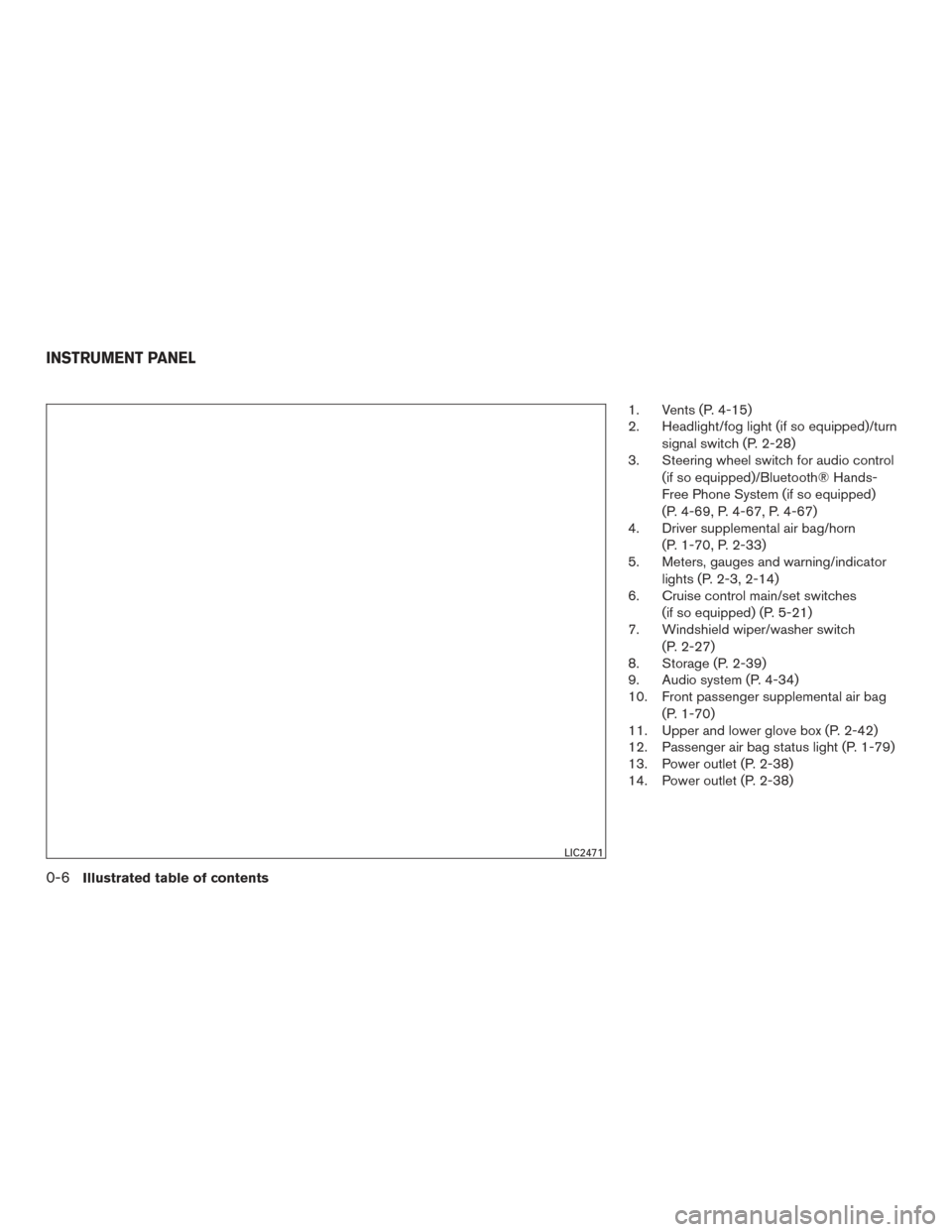
1. Vents (P. 4-15)
2. Headlight/fog light (if so equipped)/turnsignal switch (P. 2-28)
3. Steering wheel switch for audio control
(if so equipped)/Bluetooth® Hands-
Free Phone System (if so equipped)
(P. 4-69, P. 4-67, P. 4-67)
4. Driver supplemental air bag/horn
(P. 1-70, P. 2-33)
5. Meters, gauges and warning/indicator
lights (P. 2-3, 2-14)
6. Cruise control main/set switches
(if so equipped) (P. 5-21)
7. Windshield wiper/washer switch
(P. 2-27)
8. Storage (P. 2-39)
9. Audio system (P. 4-34)
10. Front passenger supplemental air bag
(P. 1-70)
11. Upper and lower glove box (P. 2-42)
12. Passenger air bag status light (P. 1-79)
13. Power outlet (P. 2-38)
14. Power outlet (P. 2-38)
LIC2471
INSTRUMENT PANEL
0-6Illustrated table of contents
Page 19 of 466
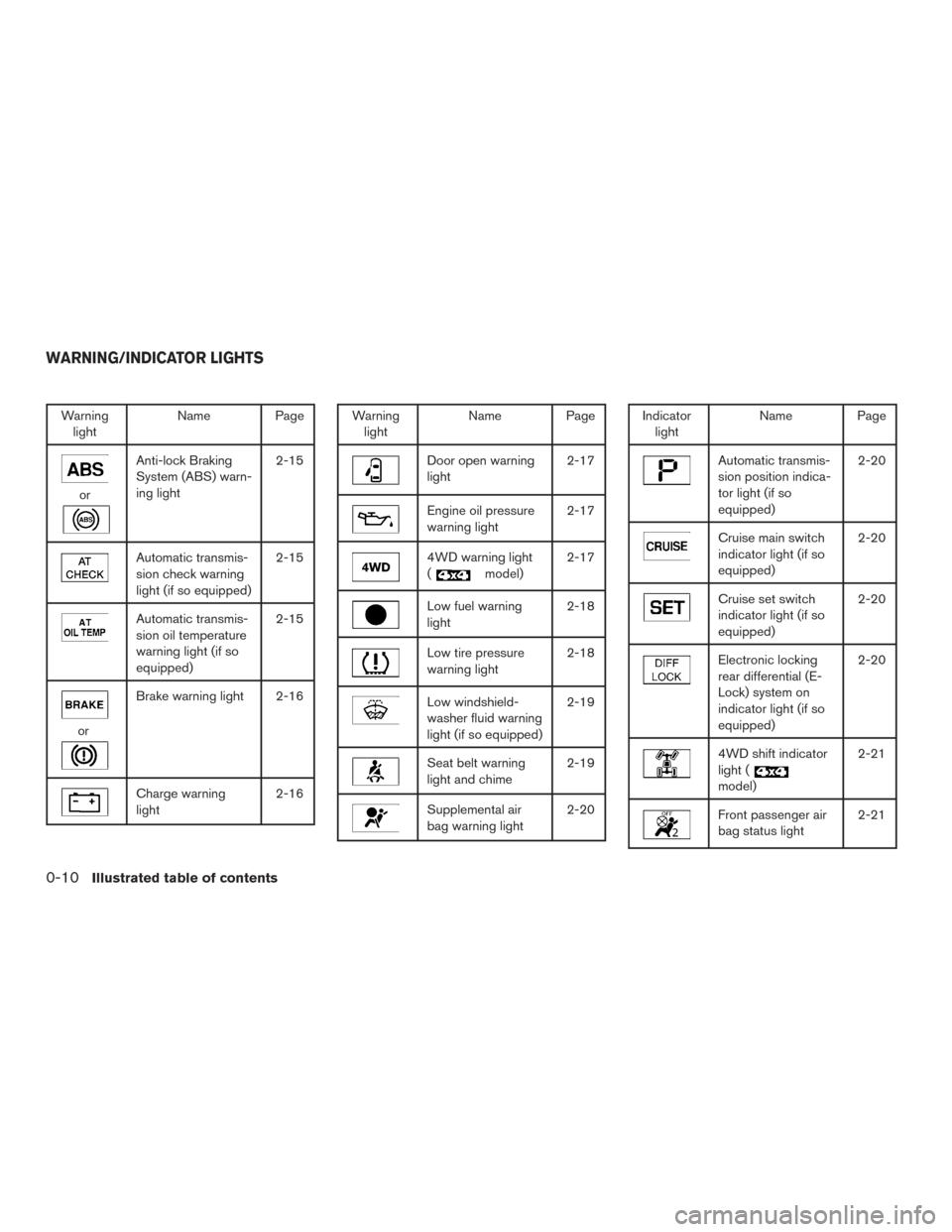
Warninglight Name Page
or
Anti-lock Braking
System (ABS) warn-
ing light 2-15
Automatic transmis-
sion check warning
light (if so equipped)2-15
Automatic transmis-
sion oil temperature
warning light (if so
equipped)2-15
or
Brake warning light 2-16
Charge warning
light
2-16
Warning
light Name Page
Door open warning
light 2-17
Engine oil pressure
warning light2-17
4WD warning light
(
model)2-17
Low fuel warning
light 2-18
Low tire pressure
warning light2-18
Low windshield-
washer fluid warning
light (if so equipped)2-19
Seat belt warning
light and chime
2-19
Supplemental air
bag warning light2-20
Indicator
light Name Page
Automatic transmis-
sion position indica-
tor light (if so
equipped) 2-20
Cruise main switch
indicator light (if so
equipped)
2-20
Cruise set switch
indicator light (if so
equipped)2-20
Electronic locking
rear differential (E-
Lock) system on
indicator light (if so
equipped)2-20
4WD shift indicator
light (
model)
2-21
Front passenger air
bag status light
2-21
WARNING/INDICATOR LIGHTS
0-10Illustrated table of contents
Page 21 of 466
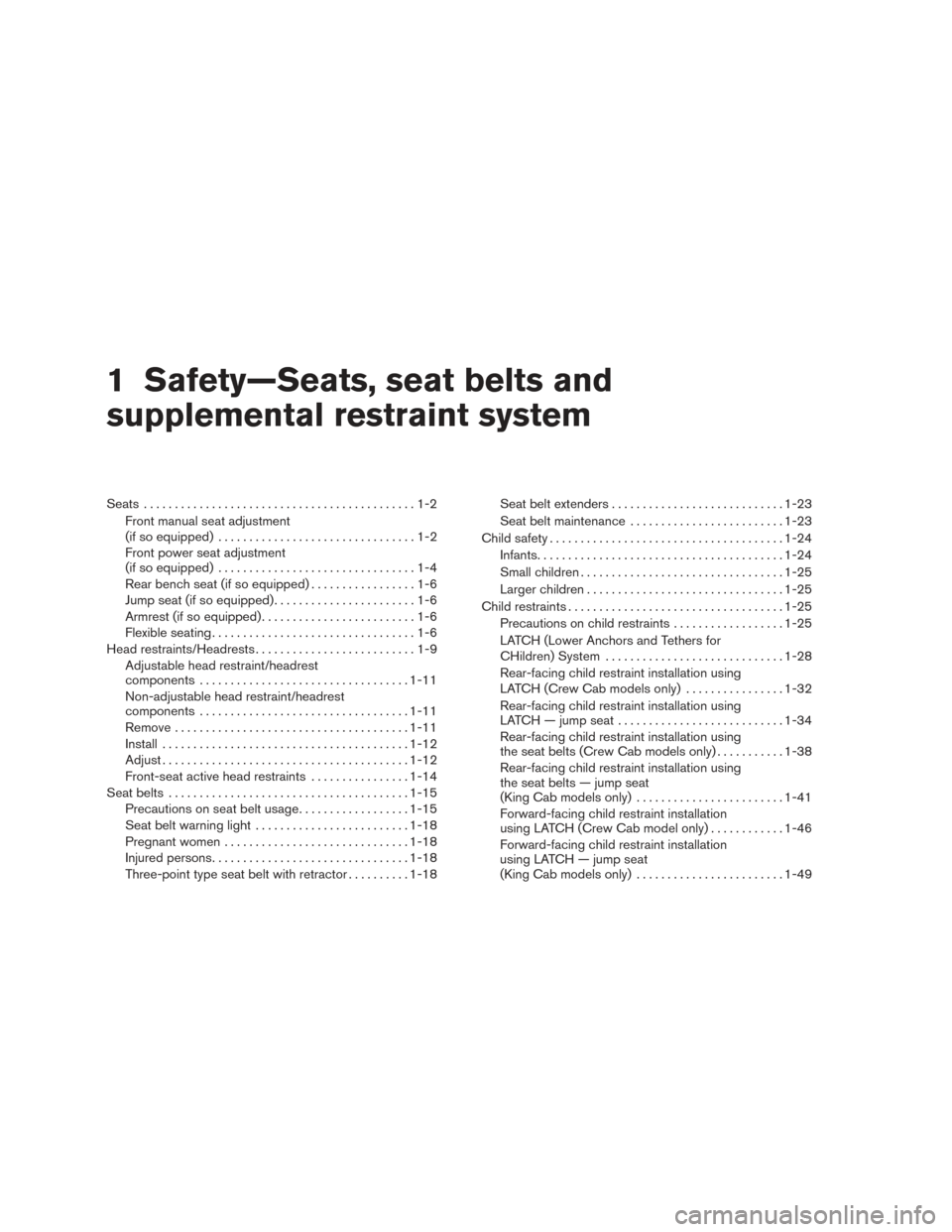
1 Safety—Seats, seat belts and
supplemental restraint system
Seats............................................1-2
Front manual seat adjustment
(if so equipped) ................................1-2
Front power seat adjustment
(if so equipped) ................................1-4
Rear bench seat (if so equipped) .................1-6
Jump seat (if so equipped) .......................1-6
Armrest (if so equipped) .........................1-6
Flexible seating .................................1-6
Head restraints/Headrests ..........................1-9
Adjustable head restraint/headrest
components .................................. 1-11
Non-adjustable head restraint/headrest
components .................................. 1-11
Remove ...................................... 1-11
Install ........................................ 1-12
Adjust ........................................ 1-12
Front-seat active head restraints ................1-14
Seat belts ....................................... 1-15
Precautions on seat belt usage ..................1-15
Seat belt warning light ......................... 1-18
Pregnant women .............................. 1-18
Injured persons ................................ 1-18
Three-point type seat belt with retractor ..........1-18 Seat belt extenders
............................ 1-23
Seat belt maintenance ......................... 1-23
Child safety ...................................... 1-24
Infants ........................................ 1-24
Small children ................................. 1-25
Larger children ................................ 1-25
Child restraints ................................... 1-25
Precautions on child restraints ..................1-25
LATCH (Lower Anchors and Tethers for
CHildren) System ............................. 1-28
Rear-facing child restraint installation using
LATCH (Crew Cab models only) ................1-32
Rear-facing child restraint installation using
LATCH — jump seat ........................... 1-34
Rear-facing child restraint installation using
the seat belts (Crew Cab models only) ...........1-38
Rear-facing child restraint installation using
the seat belts — jump seat
(King Cab models only) ........................ 1-41
Forward-facing child restraint installation
using LATCH (Crew Cab model only) ............1-46
Forward-facing
child restraint installation
using LATCH — jump seat
(King Cab models only) ........................ 1-49
Page 22 of 466
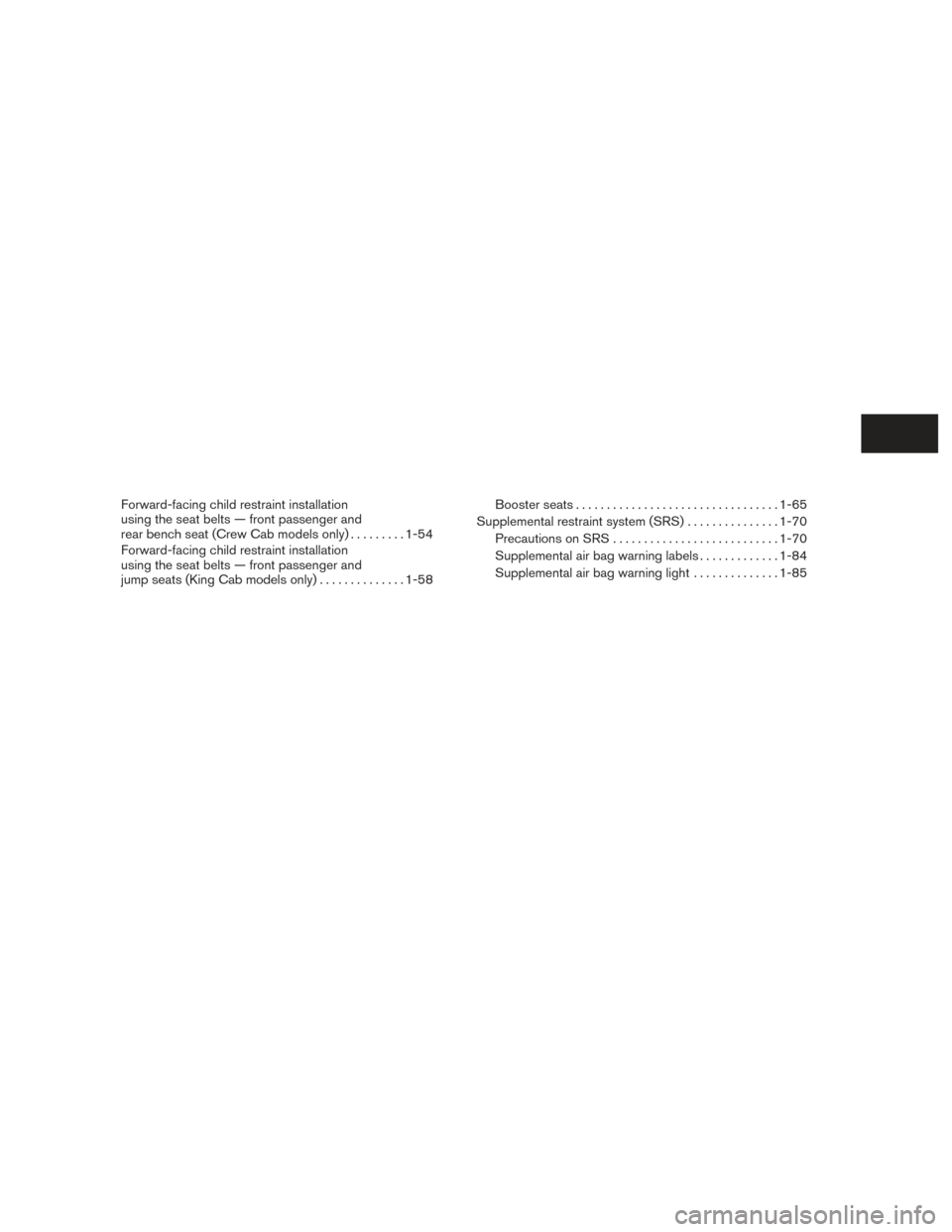
Forward-facing child restraint installation
using the seat belts — front passenger and
rear bench seat (Crew Cab models only).........1-54
Forward-facing child restraint installation
using the seat belts — front passenger and
jump seats (King Cab models only) ..............1-58 Booster seats
................................. 1-65
Supplemental restraint system (SRS) ...............1-70
Precautions on SRS ........................... 1-70
Supplemental air bag warning labels .............1-84
Supplemental air bag warning light ..............1-85
Page 38 of 466

WARNING
●Always route the shoulder belt over
your shoulder and across your chest.
Never put the belt behind your back,
under your arm or across your neck. The
belt should be away from your face and
neck, but not falling off your shoulder.
● Position the lap belt as low and snug as
possible AROUND THE HIPS, NOT THE
WAIST. A lap belt worn too high could
increase the risk of internal injuries in
an accident. ●
Be sure the seat belt tongue is securely
fastened to the proper buckle.
● Do not wear the seat belt inside out or
twisted. Doing so may reduce its
effectiveness.
● Do not allow more than one person to
use the same seat belt.
● Never carry more people in the vehicle
than there are seat belts.
● If the seat belt warning light glows con-
tinuously while the ignition is turned
ON with all doors closed and all seat
belts fastened, it may indicate a mal-
function in the system. Have the system
checked by a NISSAN dealer.
● No changes should be made to the seat
belt system. For example, do not modify
the seat belt, add material, or install
devices that may change the seat belt
routing or tension. Doing so may affect
the operation of the seat belt system.
Modifying or tampering with the seat
belt system may result in serious per-
sonal injury. ●
Once a seat belt pretensioner has acti-
vated, it cannot be reused and must be
replaced together with the retractor.
See your NISSAN dealer.
● Removal and installation of preten-
sioner system components should be
done by a NISSAN dealer.
● All seat belt assemblies, including re-
tractors and attaching hardware, should
be inspected after any collision by a
NISSAN dealer. NISSAN recommends
that all seat belt assemblies in use dur-
ing a collision be replaced unless the
collision was minor and the belts show
no damage and continue to operate
properly. Seat belt assemblies not in
use during a collision should also be
inspected and replaced if either dam-
age or improper operation is noted.
● All child restraints and attaching hard-
ware should be inspected after any col-
lision. Always follow the restraint
manufacturer’s inspection instructions
and replacement recommendations.
The child restraints should be replaced
if they are damaged.
SSS0014
Safety—Seats, seat belts and supplemental restraint system1-17
Page 39 of 466

SEAT BELT WARNING LIGHT
Both the driver’s and passenger’s front seats are
equipped with a seat belt warning light. The
warning light, located on the instrument panel,
will show the status of the driver and passenger
seat belt.
NOTE:
The front passenger seat belt warning light
will not light up if the seat is not occupied.
For additional information, refer to
“Warning/indicator lights and audible reminders”
in the “Instruments and controls” section of this
manual.
PREGNANT WOMEN
NISSAN recommends that pregnant women use
seat belts. The seat belt should be worn snug and
always position the lap belt as low as possible
around the hips, not the waist. Place the shoulder
belt over your shoulder and across your chest.
Never run the lap/shoulder belt over your ab-
dominal area. Contact your doctor for specific
recommendations.
INJURED PERSONS
NISSAN recommends that injured persons use
seat belts. Check with your doctor for specific
recommendations.
THREE-POINT TYPE SEAT BELT
WITH RETRACTOR
WARNING
●Every person who drives or rides in this
vehicle should use a seat belt at all
times. ●
Do not ride in a moving vehicle when
the seatback is reclined. This can be
dangerous. The shoulder belt will not
be against your body. In an accident,
you could be thrown into it and receive
neck or other serious injuries. You
could also slide under the lap belt and
receive serious internal injuries.
● For the most effective protection when
the vehicle is in motion, the seat should
be upright. Always sit well back in the
seat with both feet on the floor and
adjust the seat belt properly.
● Do not allow children to play with the
seat belts. Most seating positions are
equipped with Automatic Locking Re-
tractor (ALR) mode seat belts. If the seat
belt becomes wrapped around a child’s
neck with the ALR mode activated, the
child can be seriously injured or killed if
the seat belt retracts and becomes
tight. This can occur even if the vehicle
is parked. Unbuckle the seat belt to
release the child. If the seat belt cannot
be unbuckled or is already unbuckled,
release the child by cutting the seat belt
with a suitable tool (such as a knife or
scissors) to release the seat belt.
LRS0786
1-18Safety—Seats, seat belts and supplemental restraint system
Page 41 of 466

The ELR mode allows the seat belt to extend and
retract to allow the driver and passengers some
freedom of movement in the seat. The ELR locks
the seat belt when the vehicle slows down rapidly
or during certain impacts.
The ALR mode (child restraint mode) locks the
seat belt for child restraint installation.
When the ALR mode is activated, the seat belt
cannot be extended again until the seat belt
tongue is detached from the buckle and fully
retracted. The seat belt returns to the ELR mode
after the seat belt fully retracts. For additional
information, refer to “Child restraints” in this sec-
tion.
The ALR mode should be used only for
child restraint installation. During normal
seat belt use by an occupant, the ALR mode
should not be activated. If it is activated it
may cause uncomfortable seat belt ten-
sion. It can also change the operation of
the front passenger air bag. For additional
information, refer to “Front passenger air
bag and status light” in this section.WARNING
When fastening the seat belts, be certain
that the seatbacks are completely secured
in the latched position. If they are not
completely secured, passengers may be
injured in an accident or sudden stop.
Fastening the seat belts (jump seats —
King Cab models)
1. Open the jump seat. For additional informa-tion, refer to “Seats” in this section.
LRS0556
1-20Safety—Seats, seat belts and supplemental restraint system